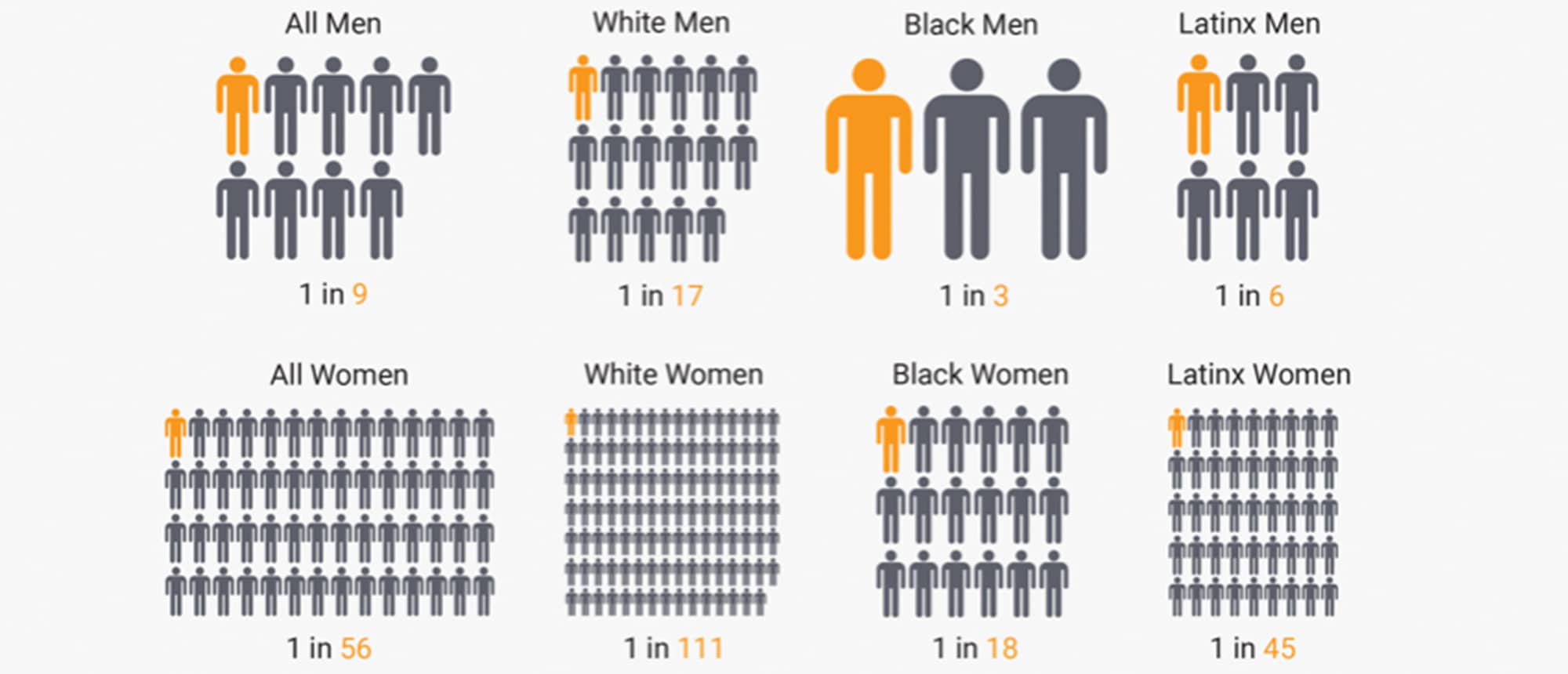Criminal Justice Facts
The United States is the world’s leader in incarceration. There are 2.2 million people in the nation’s prisons and jails—a 500% increase over the last 40 years. Changes in law and policy, not changes in crime rates, explain most of this increase. The results are overcrowding in prisons and fiscal burdens on states, despite increasing evidence that large-scale incarceration is not an effective means of achieving public safety.


How did this happen?
We started sending more people to prison.

We started sending people to prison for much longer terms.
Harsh sentencing laws like mandatory minimums, combined with cutbacks in parole release, keep people in prison for longer periods of time. The National Research Council reported that half of the 222% growth in the state prison population between 1980 and 2010 was due to an increase of time served in prison for all offenses. There has also been a historic rise in the use of life sentences: one in nine people in prison is now serving a life sentence, nearly a third of whom are sentenced to life without parole.

Mass incarceration has not touched all communities equally

Mass incarceration and public safety
Crime rates have declined substantially since the early 1990s, but studies suggest that rising imprisonment has not played a major role in this trend. The National Research Council concluded that while prison growth was a factor in reducing crime, “the magnitude of the crime reduction remains highly uncertain and the evidence suggests it was unlikely to have been large.” Several factors explain why this impact was relatively modest.
First, incarceration is particularly ineffective at reducing certain kinds of crimes: in particular, youth crimes, many of which are committed in groups, and drug crimes. When people get locked up for these offenses, they are easily replaced on the streets by others seeking an income or struggling with addiction.
Second, people tend to “age out” of crime. Research shows that crime starts to peak in the mid- to late- teenage years and begins to decline when individuals are in their mid-20s. After that, crime drops sharply as adults reach their 30s and 40s. The National Research Council study concludes:
“Because recidivism rates decline markedly with age, lengthy prison sentences, unless they specifically target very high-rate or extremely dangerous offenders, are an inefficient approach to preventing crime by incapacitation.”
As a result, the excessive sentencing practices in the U.S. are largely counterproductive and extremely costly.

Significant reforms in recent years
After nearly 40 years of continued growth, the U.S. prison population has stabilized in recent years.
This is partially a result of declining crime rates, but has largely been achieved through pragmatic changes in policy and practice. For more than a decade, the political climate of criminal justice reform has been evolving toward evidence-based, commonsense approaches to public safety. This can be seen in a variety of legislative, judicial, and policy changes that have successfully decreased incarceration without adverse impacts on public safety.
At the state level:
- California voters passed ballot measure Proposition 47 in 2014, which reclassified certain low-level property and drug crimes from felonies to misdemeanors, and will reinvest some of the fiscal savings into prevention programs
- New York policymakers reformed the Rockefeller drug laws in 2009, which imposed harsh mandatory minimum sentences for low-level drug offenses
At the federal level:
- In 2014, the United States Sentencing Commission unanimously voted to reduce excessive sentences for up to 46,000 people currently serving time for federal drug offenses
- Congress passed the Fair Sentencing Act in 2010, which reduced the disparity in sentencing between crack and powder cocaine offenses
As promising as these changes may be, we are a long way from solving our national problem of mass incarceration—and the way forward is clear.
Where do we need to go from here?
Just as a bicycle works best when it uses different gears based on the terrain, we need a justice system that has different responses for different situations—shifting gears to treatment, prevention, and long-term public safety solutions as appropriate. By taking a practical approach to criminal justice reform, we can decrease crime, enhance public safety, and make more responsible use of our resources.
In particular, we need to start by:
-
- Eliminating mandatory minimum sentences and cutting back on excessively lengthy sentences; for example, by imposing a 20-year maximum on prison terms.
- Shifting resources to community-based prevention and treatment for substance abuse.
- Investing in interventions to that promote strong youth development and respond to delinquency in age-appropriate and evidence-based ways.
- Examining and addressing the policies and practices, conscious or not, that contribute to racial inequity at every stage of the justice system.
- Removing barriers that make it harder for individuals with criminal records to turn their lives around.

